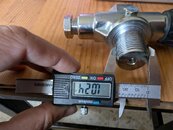pisauron
Contributor
I'm not sure I understand you correctly. If you mean that the diameter of the threads seems less than it should be, for example from worn threads, the valve/cylinder must be scrapped.
A No-go-gauge, is not supposed to go onto the workpiece. The only test that the No-go-gauge performs is that the effective diameter of the thread is not too large or small, depending on whether we are testing internal or external threads. Think of it as testing if the thread has not been “worn down” or the crest has gotten "flattened-out".
Going strictly by the book, a No-go-gauge really is not supposed to go onto the threads at all, not even a tiny bit. But because that is rather a hard bar to clear, exceptions have been made in the past. Luxfer did issue an advisory in the 1980s with regards to their aluminium cylinders with a G ¾” thread. They determined that for a cylinder valve with eleven threads, the G¾” thread could allow up to four turns on a No-go-gauge and still provide ample strength to withstand the forces.
It is important to understand that this is the total turns of the No-go-gauge combined! You have to count the turns of the No-go-gauge on the cylinder valve as well as the cylinder itself and add the two up. If they exceed four turns together, the connection is not deemed safe anymore. For cylinder valves with less than eleven threads, the maximum allowable tolerance was set to two No-go-gauge turns combined. While the G¾” thread is not in use anymore, today's ubiquitous M25x2 and ¾”–14 NPSM threads are fairly similar to that, so that the results transfer reasonably well.
In practice it is a dicey subject, especially when considering that steel and aluminium have vastly different sheer rates for their threads.
Be cautious with the No-go gauge, as it might give you a false sense of security. If the first thread is within specifications, the gauge will not be able to screw on, which is a pass criteria. However, all subsequent threads may as well be completely destroyed or absent and this test still passes. Visual inspection of the threads is imperative for this very reason.
A caliper is not a sufficient tool for thread identification or inspection of threads. You can't possibly measure the fine tolerance required accurately. To drive the point home, think about two threads, both of which have been on SCUBA cylinders or are still in use:
Thread Maximum Major Male (mm) Minimum Major Male (mm) Maximum Minor Female (mm) Minimum Minor Female (mm) ¾"-14 NPSM 26.26 26.01 24.64 24.33 G¾" BSP 26.44 26.16 24.66 24.66 M25x2 6g / 6h 24.96 24.68 23.21 22.84
The ¾"-14 NPSM and G¾" BSP threads are very close to each other, partly overlapping in sizes. To make matters worse, they differ in flank angles. A caliper can never distinguish between the two flank angles. A thread gauge however will do so easily. The ¾"-14 NPSM has a 60° flank angle, while the G¾" BSP has a 55° Whitworth flank angle.
Without a thread gauge, you will easily mix the two thread types up, creating a combination that is bound to separate violently under pressure.
The measurements of the threads you are likely going to work with are easily obtainable in engineering handbooks, or even the internet. EngineersEdge is a great resource for example. However, I want to stress again, that using a caliper is not a sufficient tool to check threads, you are virtually checking nothing. At the very best, it gives you a false sense of security, at worst you mix up threads. To identify and check threads, thread gauges are the way to go, combined with a thorough visual inspection of the threads.
Yes what I meant is the threads seemd "flattened out". Not as sharp as they used to be.
For this check I would get ring thread gauge (smooth) to check. I wonder if the smooth ring gauge can actually work on a 3/4 npsm with the fact it's angled?
Also here is photo of me now trying to check this valve with a caliper.
Strangly I get 1.024 inches on the major male. So this valve is toast I guess.




